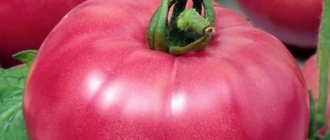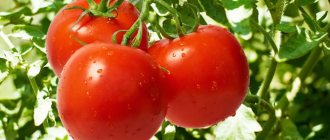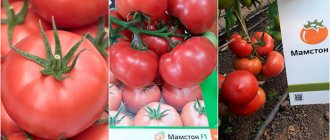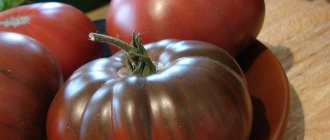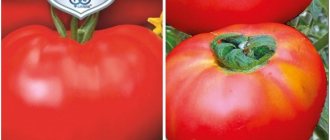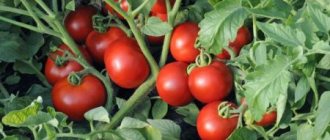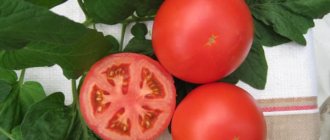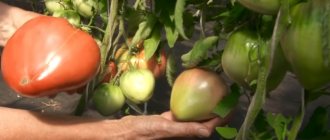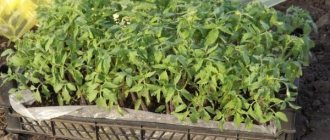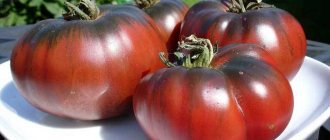Author's rating
Author of the article
Yakov Pavlovich
Professor, Head of the Department of Vegetable Growing
Articles written
153
Unpretentious, low-growing tomatoes are very popular among summer residents. La La Fa, having compact dimensions, pleases with an excellent harvest of large fruits. The hybrid is suitable for growing not only outdoors, but also in a greenhouse. A detailed description and characteristics of the La La Fa tomato variety are given in this article.
Description and characteristics of the variety
The La La Fa tomato belongs to a group of hybrid plants obtained from crossing high-yielding varieties. As a result of such crossing, a plant is born that is superior in yield to the parent forms. However, the hybrid is not able to pass on its outstanding qualities to its offspring, so such tomatoes are not left for seeds.
The originator of the Lalyaf tomato is the Gavrish company. The creators of the hybrid paid special attention to the plant’s unpretentiousness, productivity and large-fruited size. Tomatoes can be planted in a greenhouse, film greenhouse (tunnel) or in open ground.
The tomato bush grows up to 75-85 cm outdoors up to 130 cm in greenhouse conditions. The stems need staking, as they are not powerful enough to hold large fruits.
Hybrid fruits La La Fa have a round, slightly flattened shape. The skin is bright red, dense. The weight of tomatoes reaches 150 g, which classifies the hybrid as a large-fruited tomato group. The pulp is juicy, aromatic, sweet and sour in taste.
Other characteristics of La La Fa:
- ripening period from sowing to the stage of technical ripeness is 110 days (mid-season);
- yield up to 12 kg per 1 sq. m;
- friendly ripening of fruits;
- resistance to tobacco mosaic virus and fusarium.
The harvested tomato crop is suitable for fresh consumption and all types of processing.
Description of the variety
Fruit:
- Round, slightly flattened shape;
- Red color;
- With smooth, dense skin that is resistant to cracking;
- Number of seed chambers - 4-6;
- Average weight is from 130 to 160 grams.
Bushes:
- Determinate, powerful, medium foliage;
- Grows up to 150 cm;
- The leaves are dark green in color, simple in shape;
- The inflorescences are simple. The formation of the first occurs over 7-8 leaves, the subsequent ones at intervals of 1-2 leaves.
Pros and cons of La La Fa f1 tomato
Drawing conclusions from the described characteristics of the hybrid, the strengths of the plant include its large fruit and high yield. The excellent taste of tomatoes and persistent immunity to disease complement the list of advantages of the tomato.
The disadvantages of this variety include the inability of gardeners to obtain their own seeds for further propagation of La La Fa. Seed material for planting will have to be purchased annually from the manufacturer.
Features of cultivation
Sow early 83 for seedlings in late March - early April. In the phase of 1–2 true leaves, pick out. If the lower leaves of growing seedlings (not cotyledons) begin to turn yellow, then feed them with a fertilizer containing nitrogen: ammonium nitrate, urea, horse manure extract, nettle infusion or any modern concentrate that contains humic acids (humus).
Plant seedlings in the garden that are hardened, that is, accustomed to open-air conditions. Scheme for this variety: 30x50 cm or 40x40 cm. To avoid fertilizing after planting, pour a handful of humus and a teaspoon of superphosphate and potassium sulfate into each hole.
Video: planting low-growing tomatoes in the ground
Care after planting consists of watering and garter. Early 83 needs support, otherwise the bushes will collapse, the tomatoes will end up on damp ground, and can become prey for snails, slugs or pathogenic fungi. You can do without forming, then more fruits will grow, but small ones, they will begin to ripen later than the stated period. To enlarge tomatoes, break out the lower shoots up to the first flower cluster and thin out the crowns of the bushes. On each plant, leave 4-5 clusters of the first ones to set. Then the tomatoes will fill to the maximum size for the variety and will be juicy and tasty.
Growing tomatoes
The agricultural technology of the La La Fa tomato is practically no different from the cultivation of other determinate varieties. In most regions of Russia, tomatoes are not sown in open ground, but seedlings are prepared at home.
See also Description and characteristics of Japanese truffle tomato varieties
How to prepare seeds?
Branded seeds can be sown dry, as they have already been treated against diseases and have been calibrated. But to increase germination and strengthen the immunity of future plants, the seeds are processed.
- Hardening. Tomato seeds are placed in a damp cloth, wrapped in plastic wrap, and put in the refrigerator. At a temperature of +5 degrees, the seeds are hardened for several days. After hardening, they are germinated and sown.
- Germination. You can speed up the emergence of seedlings and weed out non-germinating seeds if you carry out germination. The seed material is poured into a fabric bag, wrapped in toilet paper or sprinkled between cotton pads. The material is moistened and placed in a warm place (on a radiator). After a day or three, sprouts will appear on the seeds and you can sow.
- Stimulation. Before sowing, the seeds are kept in a solution of Zircon or Epin. The drugs have a stimulating effect on the seed embryo, accelerating its awakening. Some gardeners use aloe juice (1 teaspoon per glass), succinic acid, and honey for stimulation.
On a note. To enhance the effect of the stimulating solution on the seeds, an aquarium compressor is lowered into a container of water. The seeds in the solution should be in a bag suspended in the path of the bubbles coming from the compressor.
Sowing seed material
Tomato La La Fa is sown 50-60 days before planting the seedlings in the garden. Depending on the climate of the growing region, seedlings are prepared from February to April.
The soil for the crop should be loose, fertile and crumbly. The optimal composition of the substrate: humus, manure or vegetable matter, peat, turf soil and sand. All ingredients are taken in equal proportions. For 5 liters of the finished mixture add 2 tbsp. l. complex mineral fertilizer. This will save the vegetable grower from having to feed the seedlings.
Tomatoes are sown in separate pots, to a depth of 1 cm, or in a common container according to a 2 by 4 cm pattern.
Rules for planting seedlings
Young plants can be taken outside when the air temperature rises to +18 +20 degrees and the soil warms up to +15. The same conditions are needed for seedlings that will be planted in a greenhouse or greenhouse.
Tomato bushes are planted at a distance of 40 cm from each other. Supports for the bush are immediately driven into the planting holes, but you can also install a common trellis for the entire row.
Expert opinion
Stanislav Pavlovich
Gardener with 17 years of experience and our expert
Ask a Question
Important! When removing the tomato from the pot, monitor the safety of the earthen lump.
It is recommended to deepen the stem to the first leaves, stimulating the growth of additional roots. Add 1 tbsp to the soil to fill the roots. l. complex fertilizer for tomatoes OMU. The granules gradually dissolve over the course of the season, nourishing the plant. Instead of ready-made fertilizer, you can add the following to each hole:
- 1 kg of rotted manure;
- 2 tbsp. l. ash.
See also Raspberry Giant tomatoes: yield and variety characteristics
After planting, the seedlings are watered abundantly. If the weather is hot, it is useful to irrigate the tomato foliage.
Agricultural technology
Tomatoes Minusinsk
To get a good harvest from a plant, it is necessary to properly care for it.
Growing seedlings
To speed up a good harvest, you need to sow seeds for seedlings. The optimal time for sowing seeds is March. In this case, after about 60 days, that is, in May, you can get seedlings that can be planted in the ground. It is recommended to plant seedlings in a greenhouse. Drop off times will vary because they are affected by:
- climatic conditions in the area;
- greenhouse structures;
- weather in a particular year.
The soil should be prepared for seedlings. Either a nutrient mixture or soil is suitable for it. To prepare the soil, turf soil, humus and raising agents are used.
Seeds are sown in pots and general containers. When growing a plant without diving, you need to pour a small amount of soil into the container, followed by adding it. Seeds need to be sown to a depth of 2 cm. They are covered with film or glass. When seedlings appear, they need to be exposed to light.
Need warmth and light
Seedling care
Further care of seedlings consists of the following actions:
- moderate watering (using irrigation);
- diving (when the seedling has two leaves);
- feeding (it is carried out only after the dive).
To feed seedlings, mixed fertilizer or a special composition for caring for nightshade plants is used. Fertilizing must be combined with watering. In this case, it is better not to get on the leaves.
Note! The room where the tomatoes are located needs ventilation. If sowing is done early, the plants need additional lighting. For this purpose, LEDs or fluorescent lamps are used.
14 days before transplanting, tomatoes should be accustomed to new growing conditions. Provided that the weather is warm and the air temperature has stabilized, the seedlings should be taken out onto the balcony or into the air. If not properly cared for, the growth of seedlings will be slightly delayed and the plants will begin to get sick. Hardening helps accelerate growth and develop resistance during transplantation.
Greenhouse care
In May or early June, you can plant tomatoes indoors. To do this, you need to prepare the beds in advance. In the fall they are dug up and fertilized.
Tomatoes will grow well after cucumbers, cabbage, onions or legumes. It is not recommended to apply a lot of organic fertilizers. It is necessary to add rotted manure and ash. It is recommended to add superphosphate in the fall. In spring, additional potassium salt is added.
Tomatoes are planted when the soil reaches a temperature of 14-16º. Early planting is not advisable. In this case, there is a high probability of frost returning, and under such conditions, even in a greenhouse, plants may suffer. You should choose a cloudy day. In sunny and hot weather, planting is carried out in the evening.
Landing takes place in the evening.
To plant, you need to prepare a hole, water it and plant the seedlings. They are sprinkled with soil and compacted a little. You need to plant 3 stems per square meter. If tomatoes are planted more densely, the yield may decrease.
In greenhouse conditions, seedlings should be covered with non-woven materials. They protect from sun rays and frost.
Watering
The first watering should be done a week after planting. To do this, use warm water. Then watering is done 2 times during the week. You need to focus on the weather and the condition of the plants. You need to water regularly and abundantly. Air and soil humidity should be observed and this indicator should not be allowed to increase. If tomatoes develop in conditions of high humidity, they will begin to get sick and become susceptible to infections.
To create an optimal microclimate, you need:
- ventilate the greenhouse;
- during hot periods, do not close the doors, even at night;
- mulch with hay, sawdust, wood chips or roots.
The last technique allows you to protect plants from weeds and waterlogging, which makes them sick.
Top dressing
The following fertilizers are used for feeding:
- Cow manure (1:10 dilution), bird droppings (1:20 dilution);
- Mineral fertilizers (nitrophoska is most often used);
- Sodium or potassium humates;
- Superphosphates;
- Potassium sulfate;
- Ash.
It should be remembered that nitrogen fertilizers are used at an early stage of cultivation. After tomatoes begin to bloom, the plants should receive more potassium and phosphorus at the beginning of fruit growth. The green tea fertilizer has proven itself well. This is the name of an infusion of fresh herbs in a barrel. This composition is infused for a week. Diluted in a ratio of one liter per bucket of water.
Foliar feeding should be done by spraying. Some iodine salts, boric acid and urea are added to the water. After this treatment, the reddening of the fruit accelerates.
Important! You should remember the dosages of fertilizers and never exceed them.
Pruning and harvesting
Since this variety belongs to the tall variety, the plants need pinching and bush formation. Agronomists advise growing Lyalaf tomato in two stems. The remaining shoots are removed. For the second stem, you need to leave the strongest stepson located under the first flower cluster.
For a plant to be powerful, it needs supports. Stakes with ribbons or trellises are used.
If the plant has been cared for correctly, the first fruits can be harvested in early July. In the future, the collection will continue until the beginning of autumn. It is best to pick “technically ripe” tomatoes. This is necessary so that the plant does not waste energy on their further maturation.
Green fruits ripen well indoors. At the same time, new tomato fruits will form and ripen on the bush.
Fruits La la fa
During the fruit harvest period, you can carry out preventive treatment of plants: spray them with whey, infusion of garlic, milk with iodine. Spraying with Bordeaux mixture or compounds containing copper gives excellent results.
Further care of bushes
The La La Fa tomato is undemanding in care, but in order to get especially large fruits, the plants are watered, fed and shaped.
Watering
In the absence of natural precipitation, the tomato bed is watered 2-3 times a week. Spend 3-4 liters of warm water per plant. During the ripening period of tomatoes, the frequency of watering is reduced to 1 per week.
Mulching the soil will help water the garden less often. If the soil under the bushes is covered with sawdust, straw or grass, the moisture from watering will remain in the ground longer.
Top dressing
Plants fertilized during planting are fed again during flowering and fruiting. Choosing a method of feeding the gardener. Use:
- mineral fertilizer solution;
- infusion of grass, ash, bread or manure;
- solution of iodine, boric or succinic acid.
It is equally effective to water the tomatoes at the root or spray them.
Stepsoning
La La Fa needs to remove excess shoots and form a bush. Experienced gardeners leave a pair of lower stepsons on the trunk, which form an additional harvest. The remaining shoots are pinched when they grow to 1.5 cm.
Varieties for open ground
A huge number of species with excellent yields are intended for growing vegetables in the open air. Low-growing bushes with large fruits are one of the advantages of tomatoes for the soil. Such heat-loving plants are easier to care for and do not require complex agricultural practices.
According to ripening period
Tomatoes, like other vegetable crops, are characterized by different ripening periods, from early to late.
The ripening time, color and shape of tomatoes depends on the variety.
Usually early-ripening vegetables with not large fruits and not a large harvest, but with a quick, friendly yield of ripe tomatoes. Mid-season ones also have medium sizes. Late ones are usually difficult to care for, but it is among them that you can find champions in weight, but there are not many such beauties on the bush.
By growing region
Every year, breeders create new species with high quality indicators. In stores you can buy specialized varieties of tomatoes designed for growing in certain climatic conditions. Classification by regions of Russia:
- for the Moscow region: Champion, Sweet Bunch, Honey, Pink Elephant, Fireworks, Bull's forehead;
- for the southern regions: Torch, Novice, Titan, Winner, Bison, Ermak, Gift, Mikado;
- for the middle zone: Bull's Heart, Black Prince, Uzbek (Yusupov), Moskvichka, Snowdrop, Big Brother, Spasskaya Tower;
- for Siberia: Siberian heavyweight, Ultra early ripening, Sanka, Abakan pink;
- for the Urals: Coin, Bull's Heart, Button, Countryman, Yellow Buyan, Bullfinch, Demidov;
- for the far north: Snowy Tale, Ballerina, Ladyfingers, Berdsky Large, Countryman, Oak, Gina.
An unpredictable, cold or, conversely, excessively warm climate is not a reason to refuse to grow tomatoes in open ground. Thanks to selection, varieties have been developed that grow and develop well in any terrain.
According to disease resistance
To obtain a rich harvest, you need to choose tomato varieties not only with the appropriate characteristics. It is necessary that this criterion be supplemented by such an indicator as disease resistance.
Late blight, root rot, tobacco mosaic, cladosporiosis are diseases that most often affect plantings of heat-loving crops.
A catalog of tomatoes that can withstand the onslaught of various diseases:
- Blitz;
- Koenigsberg;
- Geisha;
- Betta,
- Anyuta;
- Bohemia;
- Chio-chio-san;
- Tatiana;
- Puzata hut;
- Lights of Moscow;
- Yablonka Russia;
- Crimson giant.
Unfortunately, there are no varieties that are 100% resistant to infections. But there are hybrids that produce a harvest until the active phase of many fungal diseases and infections begins.
Diseases and pests
With increased soil and air humidity, tomatoes can suffer from fungal diseases. Late blight is especially dangerous. Protect crops from disease by observing preventive measures:
- comply with watering norms;
- spray tomatoes with Fitosporin, Baktofit 2-3 times per season.
Insects also annoy tomatoes: aphids, spider mites, cutworms. They get rid of pests by washing the trunks and leaves of plants with a soap solution, infusion of ash or garlic. Spraying with Aktara and Iskra bio helps.
Growing
Tomato "Lyana" is considered the best variety for eastern Ukraine and Moldova. There it is cultivated in open ground. In Siberia and the Central regions of the Russian Federation, it is grown mainly in greenhouses and greenhouses.
Some craftsmen successfully harvest these tomatoes right on the windowsill in their apartment. This is one of the few tomatoes that can be grown either by seedlings or by directly planting seeds in the ground. Seeds for seedlings are sown in March, and planting in open ground is carried out already at t +10-12C. Moreover, the seedless method is only suitable for planting in a greenhouse. The optimal density of arrangement is 3-4 bushes per square meter. m.
There are some features that you need to know when growing this variety. So, if tomatoes grow in a greenhouse, then they require regular pinching. In open ground you can do without it. Usually, it is recommended to stepplant a plant to obtain the earliest possible harvest. To do this, leave 1-2 main stems, and remove all emerging stepsons. If it is necessary to get a rich harvest, then all the stepsons are left in place.
Liana always pleases with the friendly ripening of fruits. Already in early August, each plant will have at least 5-6 mature clusters. The bush is low-growing and does not require staking. When growing in a greenhouse, it is recommended to regularly water the plant, loosen it, weed the soil and do 2-3 fertilizing with complex or mineral fertilizers.
In open ground, these procedures are supplemented by 3-4 foliar feedings with any growth stimulant, with the obligatory addition of fungicides to protect against late blight.
Growing technology
Tomatoes are grown in seedlings. You can prepare for planting 2 months before the planned planting of plants in open ground. According to calendar dates, this falls at the beginning of April.
Before starting planting work, you need to prepare containers, soil, and seed. The seed placement depth should be no more than 2 cm. After sowing is completed, the crops should be covered with film.
In order for the seedlings to be healthy and strong, it is necessary to properly care for them. The room temperature should be maintained within 21 degrees. As soon as the first shoots appear, the film must be removed and the containers with seedlings placed on a well-lit windowsill. We must not forget about watering, it must be regular.
Important! As soon as 2 leaves appear, a pick is required.
Description of tomato variety O-La-La and features of the hybrid
The O-La-La tomato, bred by domestic breeders, has positive reviews, as it has an impressive list of advantages. This variety can be grown both in a greenhouse and in open ground, provided it is cultivated in a warm climate. The O-La-La tomato received state certification in 2004 and is included in the register of fruits for growing under film, glass and without shelter.
Features of the plant
O-La-La tomato belongs to the category of high-yielding early ripening crops. Seeds are planted two months before the estimated time of moving the seedlings to greenhouses or open beds.
Before this procedure, you need to make sure that the soil is well warmed up. Preliminary application of fertilizers is a necessary condition for plants to grow and become resistant to disease.
The characteristics and description of the variety are indicated on the packaging. This data needs to be studied before deciding to grow O-La-La tomatoes.
The characteristics of the variety are as follows:
- The bushes grow 85-120 cm high. To prevent branches from breaking and the fruits touching the ground, a garter is performed.
- The leaves are bright green and medium in size. Inflorescences of a simple type.
- The fruits are produced in small clusters. As it ripens, the color changes from light red to crimson. Ripe O-La-La tomatoes have the correct ball shape. The pulp is dense, but not fibrous. The weight of the fruit is 180-250 g.
- The O-La-La tomato variety has a pleasant sugary taste. The pulp is crumbly. Tomatoes are universal in use. They are served in their pure form and used for preparing salads, sauces and gravy.
- The productivity of the variety is high. If you follow the agricultural management techniques, you get 8 kg of fruits from one bush. Tomatoes have good shelf life, they tolerate transportation and storage well.
In order for plants to produce a good harvest, they must be regularly watered and liquid fertilizers applied. To protect against parasites, mulch the soil with ash and hot pepper.
Advantages and disadvantages
To make an informed decision about which tomatoes to plant in the spring, you need to know the pros and cons of each variety.
O-La-La tomatoes have the following advantages:
High yield. Growing over large areas is a profitable undertaking that allows you to get a good income per season. Resistance to infectious diseases and parasites. Plants have strong immunity, instilled in them by breeders. Early maturation promotes immunity to disease. Good gastronomic characteristics. The taste of tomatoes is highly rated by users
They immediately attract attention with their pleasant color and correct shape. Tomatoes are grown by private entrepreneurs and trading companies. Long-term storage
If favorable conditions are created (temperature, humidity and light), the fruits can be stored for 3-4 months without losing their taste or appearance.
The disadvantages of this variety include difficult plant care. They need to be tied up regularly to prevent the branches from breaking off and the tomatoes not coming into contact with the ground. It is necessary to constantly carry out measures to feed the bushes and protect them from pests.
Description
The fruits are red, rounded and flattened, weighing from 120 to 160 grams, like the White filling tomato. They are collected in brushes of 4-6 pieces. The skin is smooth, dense, resistant to cracking. The pulp is without voids, which is not such a common occurrence among greenhouse varieties. The taste is standard tomato, sometimes tasters find it a bit bland.
Fruiting starts in the middle period, the first tomatoes can be harvested 110-115 days after emergence, this happens in July. It is stretched and, with proper shaping of the bush, can last until autumn frosts.
The transportability of tomatoes is good, and their shelf life is simply excellent - at low temperatures they are stored for 1.5-2 months, which allows you to extend the season for consuming fresh vegetables until winter. The purpose is universal; on forums, gardeners admit that the first La La Fa tomatoes are eaten with pleasure in salads, and the subsequent ones are canned. The fruits look good whole in jars and retain their taste when cooked.
Description of the hybrid tomato Kasatik: advantages and disadvantages
The hybrid tomato Kasatik f1 appeared on the domestic market 2 years ago. This variety was created at the Russian breeding enterprise "Gavrish". For many years, the company has been creating unique varieties of tomatoes that tolerate the difficult climatic and weather conditions of our country.
For the selection of Kasatik f1, tomatoes were used, which are most popular among farmers and consumers of these products. The plant feels equally good in open ground, in greenhouses and greenhouses.
Tomatoes Kasatik f1 are characterized by stable and uniform ripening throughout the entire growing period. A high yield is a worthy reward for the money and labor invested in the plant.
General characteristics of tomato
Breeders tried to embody in Kasatik f1 the qualities by which gardeners select tomatoes. This is a high yield garden crop. With minimal care, it is 18-20 kg per 1 m². Such indicators allow you not only to feed a large family, but also to make a good profit on the sale of surplus. Feedback from farmers indicates that growing this variety can bring good profits from sale on the market.
Mature bushes reach an average height of 110-130 cm. Plants can be grown even in small greenhouses with a good flow of fresh air. The stems and branches are strong and thick, gray-green in color. At the beginning of fruit ripening, a garter is necessary. The leaves are deep green and medium in size.
The fruits are bright red and spherical in shape. Fully ripened tomatoes weigh 220-250 g. The pulp is dense and juicy, with a pronounced tomato taste. The skin is thin and dense, resistant to cracking when dropped and under pressure. The fruits are served raw and used for preparing salads, canned food and hot dishes. After thawing and cooking, tomatoes retain their integrity.
The seeds are packed in a paper bag. All the positive properties of the hybrid appear only in the first season. The seeds of ripened fruits are split into varieties that were used in the selection of Kasatik. The manufacturer does not recommend using them for collection and subsequent planting.
Pros and cons of a hybrid variety
Kasatik tomatoes are very popular among gardeners.
People value this variety primarily for the following properties:
- Excellent taste.
- Resistance to infectious diseases. Plants are immune to diseases such as spotting, crown rot, verticillium and cladosporiosis.
- Versatility. Ripe tomatoes are eaten fresh, boiled, fried and canned.
- Attractive appearance. The fruits stand out with their rich color, size and regular shape.
- Predictability of the harvest and its ripening time. The berries are evenly distributed along the height of the bush. There is no need to add supports as they mature.
- Satisfactory keeping quality. Subject to careful transportation and proper storage, ripe tomatoes retain their quality for 2 months.
The disadvantage of tomatoes is that they are difficult to care for. In this regard, plants require strict adherence to the recommendations specified by the manufacturer.
Growing tomatoes
The start of fruiting in the open ground should be planned for the beginning of June, when consistently warm weather sets in. Seedlings can be planted in heated greenhouses at the end of April. The seed ripening period is 85-90 days. After removing them from the packaging, they need to be disinfected and hardened in the cold. The procedure must be carried out in stages, gradually increasing the time spent in the cold.
The seeds are immersed in fertilized soil to a depth of 2 cm. The incubator is constantly irrigated. At first, seedlings need lighting and maintaining a constant temperature. Picking is carried out after the formation of 2 true leaves. Transplantation into the ground should be carried out carefully so as not to damage the root system. The manufacturer recommends using a 40x60 cm pattern.
